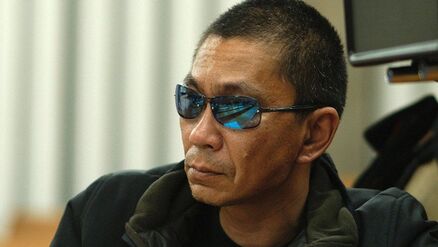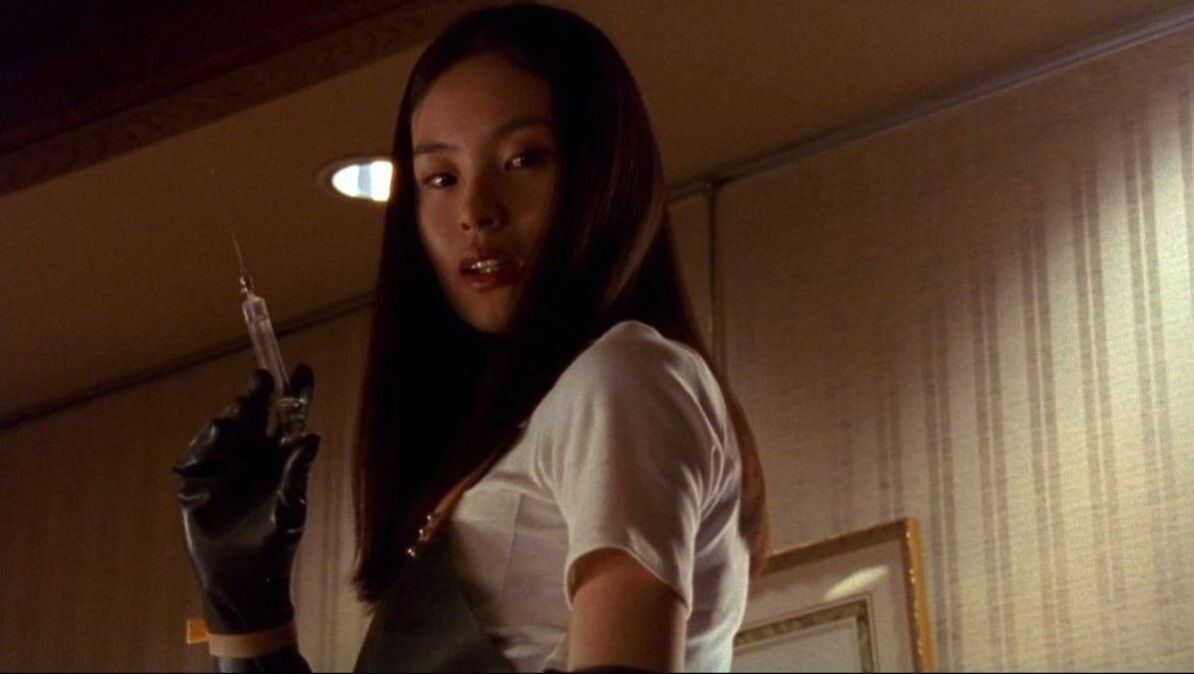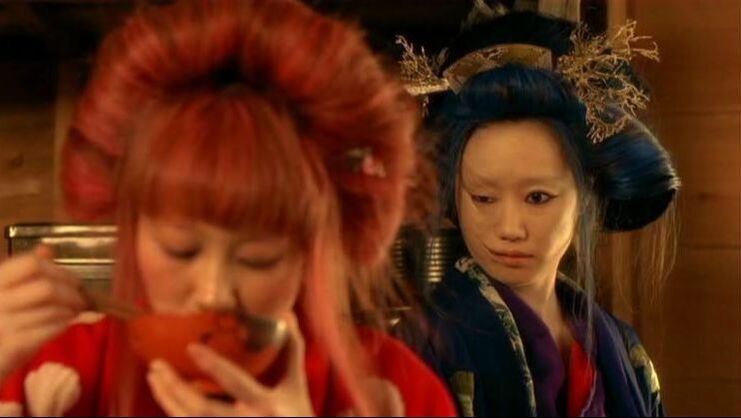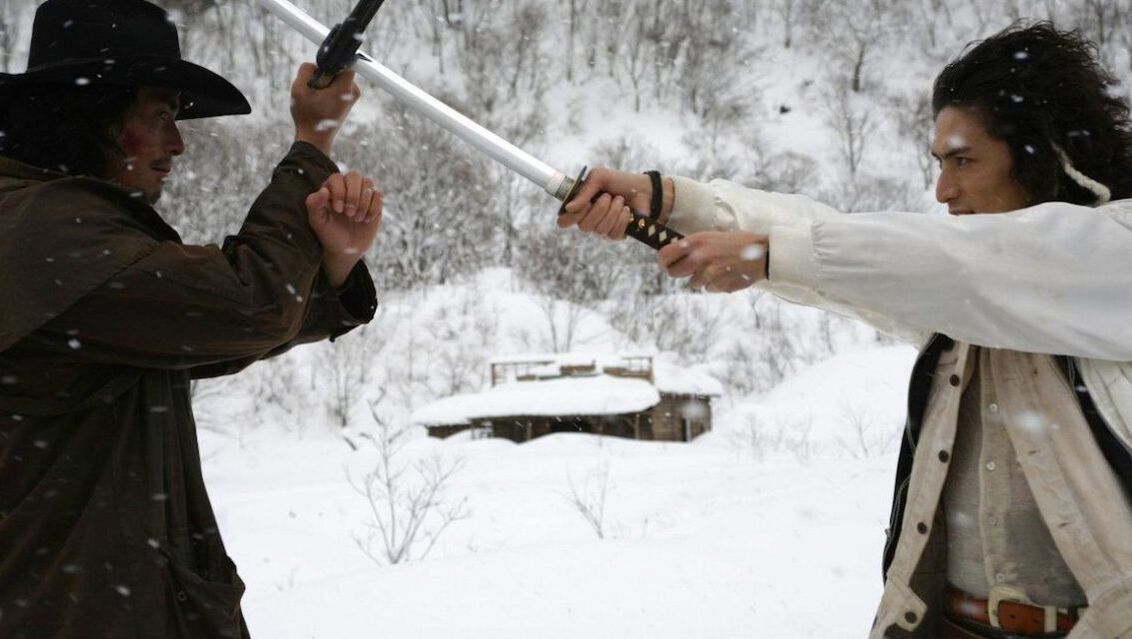 Grotesque, barbaric, repulsive. There are many words to describe the horror genre, but one seldom often used is beautiful... ...Now calling the grotesque and obscene beautiful may leave some of you scratching your heads or questioning my sanity, but there has been a long history of artists doing just that. From the surrealist paintings of Francis Bacon to the bizarre horrors put to celluloid by one of the most prolific filmmakers of our time...Takashi Miike. Miike boasts an illustrious and somewhat controversial filmography with over 110 directing credits to his name according to his IMDb page. While more well known for his gruesome blood-soaked tales, he has also directed family friendly pictures and lighthearted romps in a similar vein to Robert Rodriguez (who frequently collaborates with Quentin Tarantino, an admirer of Miike's work, just a little fun fact for those that like to play six degrees of separation). While Miike’s work predominantly started in the 1990s with television productions and direct to video releases, it wasn’t until 1999 that the world would know his name and what terrifying visuals he could bring to cinema with Audition. The film, which premiered at the Vancouver International Film Festival, tells the story of widower Shigeharu Aoyama (Ryo Ishibashi) who after the urging of his film producer friend decides to hold a casting call in hopes of finding Aoyama a new wife. Enter Asami Yamazaki (Eihi Shiina), a somewhat shy and enchanting beauty that wins the “part” after making an impression on Aoyama. There’s something about Yamazaki that isn't quite right and it is here that Miike begins to build the dread as we watch Yamazaki unmoving and staring at the phone waiting desperately for a call with a large, burlap sack sitting ominously in the background. When you ask people what scene from the film sticks with them it is this scene or perhaps the other more well-known finale that has become iconic in the horror community. While the gore of this moment is not in your face and prolonged like in other films, it's the implied pain and anguish plastered across Ishibashi’s face that makes us actually feel it as we watch Shiina’s gleeful, terrifying performance. It's here in these two scenes that we see Miike’s way of showcasing the beauty in his films. So let’s talk about one of these scenes to see what exactly I mean. From the bag scene we see close ups of the phone with the bag in the foreground and these little hints of yellow and orange lighting the scene as it switches to focusing on Yamazaki’s back, where we see bits of her spine peeking out from underneath her skin. The scene then switches to a medium shot giving us the full image of the room we find ourselves in. Miike lets us feel settled and lets that feeling of dread creep in with moments of uncomfortable silence finally broken by the sound of the phone ringing. Audition (1999) There’s one small shot in this scene in particular where the phone rings and we go back to a close up shot, watching Yamazaki’s head slowly rise. While the camera is focused on her, Miike has built the tension up so well that our focus stays on the bag in the foreground, so when movement occurs in the bag it catches us by surprise and supplants itself as a moment that sticks with you long after the scene has passed. Is it really any wonder that Audition is by today’s standards considered one of the best horror films ever? While the film wasn’t a huge success in Japan, its mainstream success in the other parts of the world, especially during its initial run in the film festival circuit, really goes to show how powerful word of mouth can be and how film festivals can introduce audiences to new stories of terror. Miike would grow his filmography adding another chapter in the Dead or Alive saga and would court controversy again in 2001 with the release of Ichi the Killer, an adaptation of the seinen manga series written by Hideo Yamamoto. The film tells the story of a yakuza enforcer (Tadanobu Asano) tasked to find his missing boss, who crosses paths with a sadistic killer named Ichi (Nao Ōmori). Miike manages to take what he did with Dead or Alive and Audition and merge the two styles, creating a film that would cause enough controversy and end up banned in several countries upon its release in theaters after its run at the 2001 Toronto International Film Festival. Miike would continue directing, finishing his Dead or Alive series with its final entry in 2002 along with churning out film after film until courting controversy again in 2005 with his entry in the Masters of Horror anthology series, Imprint. This is by far what many would say is one of Miike’s most disturbing and grotesque works to the point that even Showtime was hesitant to show it in its entirety despite Masters of Horror usually allowing their masters of horror to run free. What perhaps makes Imprint one of Miike’s more interesting works is the way he weaves this story of torment and what is essentially a ghost story in his own unique style. I would dare say that, between the three most controversial films he is known for, this is the most beautiful from a cinematography stand point. The scenes between Billy Drago’s Christopher and our narrator of this horrifying tale, played by Youki Kudoh, have these muted colors, but when telling her tale, the use of color, especially the color red, appears brighter. While the torture scene the film is known for is rather prolonged and excessive, it feels very much like Miike’s style and though the film never aired in the anthology series it did make its debut at the Yubari Internation Fantastic Film Festival in 2006 and was released on DVD by Anchor Bay Entertainment. Masters of Horror: Imprint (2005) Never one to let these controversies keep him down, Miike would do what he does best...keep working and it was in 2007 where Miike released his most underappreciated film or at least not as well known as Ichi, Audition and Dead or Alive. The spaghetti western inspired film Sukiyaki Western Django. Now if you have ever watched any of Miike’s films, especially his action movies, then you know that the fight scenes are well choreographed and masterfully shot. One such fight from this movie showcases what Miike can do with a limited budget, ($3.8 million in this case, which is low considering most Hollywood blockbusters easily surpass that). One of my absolute favorite fight sequences is the final confrontation between the hero known only as the Gunman (Hideaki Itō), a nod to Clint Eastwood’s Man with No Name from Sergio Leone’s Dollars Trilogy and Akira Kurosawa’s Ronin characters seen in films like Yojimbo. It's rather ironic that Miike would pay tribute to the spaghetti western in his own style given that Kurosawa’s work is what inspired Leone’s westerns. We see this as the nameless hero faces off against Yoshitsune (Yusuke Iseya) in what can only be described as one of the best bringing a sword to a gunfight moments ever put to the screen. The film boasts a wonderful use of color, especially during this sequence with snow falling around the pair, that you can’t help but wonder if Miike took a little bit of inspiration to use the snowy imagery in this climactic battle from Quentin Tarantino’s 2003 film Kill Bill Volume 1, who, fun fact, cameos in the film as a cowboy. But then again, the imagery of blood against the snow has been used in films long before and after Miike and Tarantino’s work. Miike would follow these action packed films with 2010’s 13 Assassins and perhaps one of my absolute favorite films by Miike and one of the best adaptations he has done of manga and anime works, his 2017 film Blade of the Immortal. Based on the Blade of the Immortal manga written by Hiroaki Samura and the anime of the same name, the film tells the story of Manji (Takuya Kimura), a samurai cursed with immortality thanks to some bloodworms implanted in his body. Manji runs into a young girl named Rin (Hana Sugisaki) who seeks Manji’s services to avenge the death of her father. The film boasts some of Miike’s best visual sequences and fight scenes. It's bloody brilliant and at the heart of the story we see a man cursed with immortality and wishing for death to find something to stay alive and keep fighting for. This is another aspect of Miike’s films that I have yet to touch upon until now but the way he utilizes his actors to deliver absolutely astounding performances is what makes his films so memorable and talked about. From Shiina showing that the female character in a horror film isn't always the dainty damsel in distress and can be just as vicious and maniacal as the men to Kimura portraying a broken man that can literally put himself back together again. Sukiyaki Western Django (2007) Miike would follow the success of these films with other adaptations of anime and manga from JoJo's Bizarre Adventure (I have yet to see his adaptation but can only imagine the kind of batshit insanity that he can deliver in the JoJo Universe) to Ace Attorney. Takashi Miike is a versatile, always busy director that doesn’t just stick to one genre or one type of film. He is constantly showing the world what he can do from the absolutely horrifying and grotesque to musicals. He is the swiss army knife of directors and how he finds time to direct all these films I will never know but I for one will always watch them even if it's the magical girl series Girls × Heroine. One thing for sure in his illustrious and controversial career is that there’s nothing Takashi Miike can’t do. By Kalani Landgraf With the rise of attacks against Asian Americans and Pacific Islanders, please stand with us and stop AAPI Hate. You can find information on how you can help at https://stopaapihate.org/actnow/
0 Comments
Leave a Reply. |
Archives
March 2023
|



 RSS Feed
RSS Feed